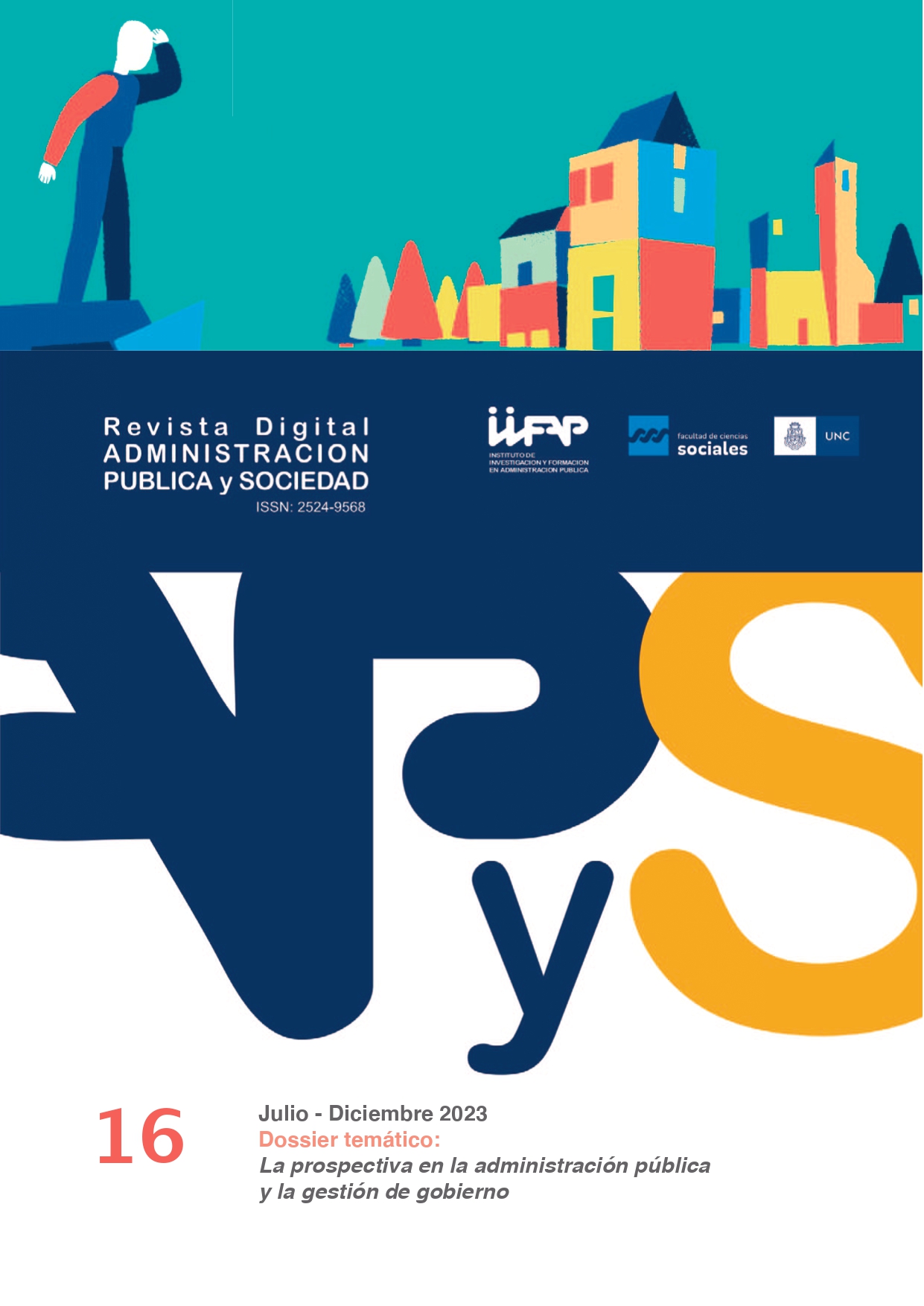La relación Estado-Ciudadanía mediante tecnologías digitales Situación actual y reflexiones sobre el futuro en la administración pública nacional argentina
Contenido principal del artículo
Resumen
Este trabajo presenta un estudio prospectivo centrado en el análisis de las tecnologías digitales en la Administración Pública argentina, llevado a cabo por la Unidad de Prospectiva y Escenarios Futuros del Instituto Nacional de la Administración Pública.
La investigación integra un marco conceptual que incorpora las nociones de sistema sociotécnico abierto y tecnologías organizacionales, así como los modelos de gobierno electrónico, digital y abierto.
A su vez, emplea una estrategia metodológica que se desarrolla en varias etapas, incluyendo revisión de literatura, entrevistas, grupos focales y conversatorios, además del procesamiento de la información a través de softwares especializados que asisten en el diseño de escenarios futuros.
En la línea de base, se analizan cuatro sistemas: Sistema Integrado de Información Financiera Internet (e-SIDIF), Gestión Documental Electrónica (GDE), Trámites a Distancia (TAD), y Mi Argentina.
Para enriquecer las siguientes fases del estudio, en función de la información obtenida, se introducen cuatro ejes claves para el análisis de las tecnologías digitales: la infraestructura crítica, la transformación organizacional, el vínculo con la ciudadanía, y la gobernanza de datos y algorítmica.
Además, la investigación proyecta posibles escenarios futuros, relacionando sus resultados con tres modelos de Administración Pública diferentes: Nueva Gerencia Pública, Poligobernanza y Neoweberianismo.
Dentro de este marco, el presente artículo se propone, por un lado, dar cuenta del proceso desarrollado a lo largo de la investigación. Y por otro, profundizar en el análisis de uno de los ejes propuestos para el estudio, el vínculo del Estado con la ciudadanía.
Detalles del artículo

Esta obra está bajo una licencia internacional Creative Commons Atribución-NoComercial-CompartirIgual 4.0.
Los autores/as que publiquen en esta revista, aceptan los siguientes términos de la política de derechos de autor:- Los autores/as conservarán sus derechos de autor (esto incluye el copyrigth) y garantizarán a la revista el derecho de primera publicación de su obra, el cuál estará simultáneamente sujeto a la Licencia de reconocimiento de Creative Commons: No se permite un uso comercial de la obra original ni de las posibles obras derivadas, la distribución de las cuales se debe hacer con una licencia igual a la que regula la obra original.
- Los autores/as podrán adoptar otros acuerdos de licencia no exclusiva de distribución de la versión de la obra publicada (p. ej.: situarlo en un repositorio institucional o publicarla en un libro) siempre que se indique la publicación inicial en esta revista.
- Se permite y recomienda a los autores/as difundir su obra a través de Internet (p. ej.: en repositorios institucionales o en su página web) luego del proceso de publicación, lo cual puede producir intercambios interesantes y aumentar las citas de la obra publicada. (Véase El efecto del acceso abierto).
Cómo citar
Referencias
Blutman, G. y Cao, H. (2019). El futuro del Estado en la Argentina. Escenarios en disputa hacia el año 2030. EDICON.
Blutman, G., Cao, H. [et al.]. (2023). Materia Estado. El futuro del empleo público, las tecnologías digitales y las estructuras estatales. Instituto Nacional de la Administración Pública.
Cao, H. y Vaca, J. (2019). Dialéctica del desarrollo argentino entre el territorio y la sociedad de la información. Revista de Ciencias Sociales, 10(35), 153-171.
Emery, F. E. (1959). Characteristics of socio-technical systems. (Document N.° 527). Tavistock Institute.
Estévez, E. y Solano, M. (2023, 24 de mayo). Revolución de la IA: desafíos y oportunidades para la Administración Pública en la Era Digital. CIPPEC.
Felcman, I. y Blutman, G. (2020). Cultura organizacional: nuevos dioses y la búsqueda del eslabón perdido para la transformación del Estado. Cuadernos del INAP (CUINAP), 1(18).
Memorandum for the Heads of Executive Departments and Agencies. Transparency and Open Government. Publicado en el Federal Register el 26 de enero de 2009.
Organización para la Cooperación y el Desarrollo Económicos (2019). Índice de Gobierno Digital OCDE 2019. Resultados y mensajes clave.
Páez Arenas, A., Chirino, C., Bisurgi, F. y Rodrigo, R. (2023). Los desafíos sociotécnicos digitales para el desarrollo de las administraciones públicas futuras. Cuadernos del INAP (CUINAP), 4(111).
Pasmore, W. & Khalsa, G. (1993). The contributions of Eric Trist to the social engagement of social science. Academy of Management Review, 18(3), 546-569.
Suárez, F. y Felcman, I. (2020). Tecnología y Organización. Cuadernos del INAP (CUINAP), 1(38).
Suárez, F. y Felcman, I. (1975). Tecnología y Organización. El Coloquio.
Thompson, J. D. (1967). Organizations in Action: Social Science Bases of Administrative Theory. McGraw-Hill.
Trist, E. L. & Bamforth, K. W. (1951). Some social and psychological consequences of the longwall method of coal-getting. Human Relations, 4(1), 3-38.
Trist, E. L., Higgin, G. W., Murray, H. & Pollock, A. B. (1963). Organizational choice: Capabilities of groups at the coal face under changing technologies. The loss, rediscovery & transformation of a work tradition. Tavistock.
Van Dijk, J. & Hacker, K. (2003). The Digital Divide as a Complex and Dynamic Phenomenon. The Information Society, 19(4), 315-326.
Zuiderwijk, A., Chen, Y. C. & Salem, F. (2021). Implications of the use of artificial intelligence in public governance: A systematic literature review and a research agenda. Government Information Quarterly, 38(3), 101577.

